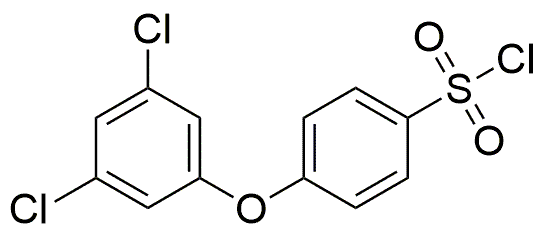4-(3,5-Dichlorophenoxy)benzenesulfonyl chloride is widely utilized in research focused on:
- Pharmaceutical Development: This compound serves as an important intermediate in the synthesis of various pharmaceuticals, particularly those targeting inflammatory diseases and cancer. Its ability to modify biological activity makes it a valuable tool for drug formulation.
- Agricultural Chemicals: It is used in the production of herbicides and pesticides, contributing to effective weed management in crops. This application helps improve agricultural yields while minimizing environmental impact.
- Material Science: The compound is employed in the development of specialty polymers and coatings, enhancing properties such as durability and resistance to chemicals. This is particularly beneficial in industries requiring robust materials.
- Analytical Chemistry: It acts as a reagent in various analytical techniques, aiding in the detection and quantification of specific compounds. This application is crucial for quality control in manufacturing processes.
- Research Reagents: As a versatile reagent, it is used in organic synthesis and chemical research, allowing scientists to explore new reactions and develop innovative compounds. This flexibility supports advancements in multiple scientific fields.
General Information
Properties
Safety and Regulations
Applications
4-(3,5-Dichlorophenoxy)benzenesulfonyl chloride is widely utilized in research focused on:
- Pharmaceutical Development: This compound serves as an important intermediate in the synthesis of various pharmaceuticals, particularly those targeting inflammatory diseases and cancer. Its ability to modify biological activity makes it a valuable tool for drug formulation.
- Agricultural Chemicals: It is used in the production of herbicides and pesticides, contributing to effective weed management in crops. This application helps improve agricultural yields while minimizing environmental impact.
- Material Science: The compound is employed in the development of specialty polymers and coatings, enhancing properties such as durability and resistance to chemicals. This is particularly beneficial in industries requiring robust materials.
- Analytical Chemistry: It acts as a reagent in various analytical techniques, aiding in the detection and quantification of specific compounds. This application is crucial for quality control in manufacturing processes.
- Research Reagents: As a versatile reagent, it is used in organic synthesis and chemical research, allowing scientists to explore new reactions and develop innovative compounds. This flexibility supports advancements in multiple scientific fields.
Documents
Safety Data Sheets (SDS)
The SDS provides comprehensive safety information on handling, storage, and disposal of the product.
Product Specification (PS)
The PS provides a comprehensive breakdown of the product’s properties, including chemical composition, physical state, purity, and storage requirements. It also details acceptable quality ranges and the product's intended applications.
Certificates of Analysis (COA)
Search for Certificates of Analysis (COA) by entering the products Lot Number. Lot and Batch Numbers can be found on a product’s label following the words ‘Lot’ or ‘Batch’.
*Catalog Number
*Lot Number
Certificates Of Origin (COO)
This COO confirms the country where the product was manufactured, and also details the materials and components used in it and whether it is derived from natural, synthetic, or other specific sources. This certificate may be required for customs, trade, and regulatory compliance.
*Catalog Number
*Lot Number
Safety Data Sheets (SDS)
The SDS provides comprehensive safety information on handling, storage, and disposal of the product.
DownloadProduct Specification (PS)
The PS provides a comprehensive breakdown of the product’s properties, including chemical composition, physical state, purity, and storage requirements. It also details acceptable quality ranges and the product's intended applications.
DownloadCertificates of Analysis (COA)
Search for Certificates of Analysis (COA) by entering the products Lot Number. Lot and Batch Numbers can be found on a product’s label following the words ‘Lot’ or ‘Batch’.
*Catalog Number
*Lot Number
Certificates Of Origin (COO)
This COO confirms the country where the product was manufactured, and also details the materials and components used in it and whether it is derived from natural, synthetic, or other specific sources. This certificate may be required for customs, trade, and regulatory compliance.

